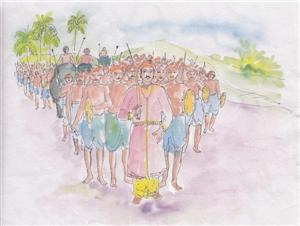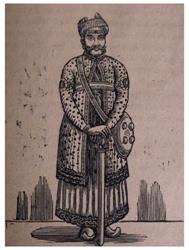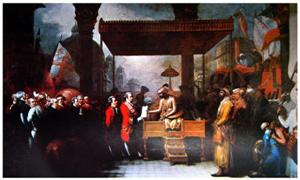Seven Years War in Europe.
The English lay the foundation of their empire by the Battle of Buxar.
The Zamorin visits Travancore.
Hyder Ali attempts to attack Malabar

1763
The English is Advancing Destroying the Dreams of the French
The Dutch are in a state of dilemma in Kerala. The repercussions of the fierce war raging between the British and the French in Carnatic are reflected in northern Kerala.

The Dutch faced difficulties in getting pepper and other spices. The French has established trade relations with Kolathiri and other local rulers. Furthermore, they have been supplying to them clandestinely arms. In the meanwhile the English has been exerting pressure quite confidentially over the local rulers of Neeleswaram, Kottayam and Cannannore to drive out the French from their territories. Now the Dutch power has no relevance at these areas. The state of affairs in Cochin is not different. Because of the Treaty of Mavelikkara the countries that stood with the Dutch turned against them. But at the same time the influence of the Dutch over the rule of Cochin is still remained. When they signed over the Treaty of Mavelikara the Dutch estimated that they could get pepper from the countries to be vanquished by the Marthanda Varma and move on aimed at trade. This is the reason why pepper was included as the main item in the Treaty. But the events took place after it made it clear to them the fact that Travancore was not keen in implementing the Treaty. It is during this period that Marthanda Varma passed away and his nephew Karthika Thirunal Rama Varma became the king. The Dutch officials estimated that the new king was strong and valourous like Marthanda Varma. The Dutch are miffed at the indications that the new king is going to establish relations with Cochin direct.

The French rulers were infuriated at the seizure of French trade centres in India by the British. When the news of the seizure of Chandra Nagar reached France the French sent to India a fleet captained by Count de Lally. It led to the Third Carnatic War which broke out in 1758 the year in which Marthanda Varma breathed his last. At first Lally was able to obtain success since the British forces were mostly in Bengal. The Dutch military might exhibited in territories including Malabar affrighted the English. But the English forces came over from Bengal at a faster pace and captured the French centres located at Pondicherry and at Mahe in Kerala. The third Carnatic war ended in the failure of the French in 1763, when the Seven Years War in Europe too ended. Then the French got back Pondicherry and Mahe and all by means of the Treaty but their dream to establish an empire in India extinguished. It was in the midst of the Seven Years War that the king of England, George II passed away and George III took over the reins of power. With the death of Rama Varma, the King of Cochin, in 1760 Veera Kerala Varma became the king. He was desirous of friendly ties with Travancore while the Zamorin at times was attacking Cochin and seizing territories of it. In the meanwhile Komi Achan, the prime-minister of Cochin, came over to Travancore for negotiations and Travancore agreed that it would help to retake the possession of Cochin. In 1762 Veera Kerala Verma came over at Thiruvananthapuram and visited Karthika Thirunal Rama Varma, the King of Travancore, as a result of which a new treaty was signed which was later ratified and accepted by taking a pledge by Komi Achan, the prime minister of Cochin, and Ayyappan Marthanda Pillai, the Diwan of Travancore. Later led by Ayyappan Marthanda Pillai and De Lannoy the troops of Travancore reached Cochin driving out the Zamorin forces which were occupying the territories of Cochin. The Zamorin, at last, requested for truce, agreeing that he would surrender the territories conquered. As per the treaties signed Travancore secured Alangad and Paravur which were submitted later at the family deity Sree Padmanabha by the king following the policy of his late uncle.

Karthika Thirunal Rama Varma
In 1763 the year in which the Seven Years War in Europe and the Carnatic War in India ended. The Zamorin himself came over Travancore and visited Karthika Thirunal Rama Varma and held talks with him when the former agreed to pay war indemnity to Cochin and to establish abiding peace. But there was no doubt that this move was on account of the perception on the part of the three powers with regard to the forthcoming invasion to Kerala by Hyder Ali of Mysore. And thus for the first time since the arrival of Europeans the three powerful forces of Kerala--Travancore, Cochin and the Zamorin-- lined up under the flag of unity .
Still dissatisfied with the conferment of the Zamindari right of the 24 Parganas Clive was coveting to conquer the whole of India by clumsily making use of lust for power and perverted strategies. Armed with the governorship of the English East India Company in Bengal he became more demanding and it resulted in the open expression of disenchantment by the Nawab Mir Jaffar. Clive then started moves to pull out Mir Jaffer from the throne and enthrone Mir Kasim the son-in-law of Nawab. Finally the new Nawab gave to English East India Company the territories of Bardwan, Midnapre and Chittagong as gifts. But before long new Nawab and the English quarrelled and with this Mir Jaffar was again installed in the throne. An enraged Mir Kasim, forging an alliance with the Nawab of Oudh and the Mughal emperor fought off the English at the battle field at Buxar in 1674. The success was with the English. Roaming here and there as an elusive fugitive Mir Kasim embraced death as an orphan at a place near Delhi. With the victory reaped at the Battle of Buxar the dream of establishing an empire in India started to blossom among the English. Clive, instrumental in making the Mughal emperor to sign over a Treaty, was conferred with the title Diwani of Bengal, Bihar and Orissa by the latter. Thus the Company got the right to collect tax from the people and it was required to pay to the Mughal Empire a portion of it. What we see is the transformation of the English East India Company which came to India for the purpose of trade, to the tax collector of the most important heart land of India. So it is natural that they have a lust to swallow India.
It is Hyder Ali of Mysore who perceived for the first time that South India is fast being herded under the Union Jack and that it is to be prevented at any cost. An illiterate but gifted with gallantry, decisiveness and productive intelligence he raised to the position of Nayak in the armed forces of the Wodayar dynasty of Mysore. Later he became Foujdar at Dindikal. He had shown intelligence in modernising the armed forces and creating fire power. Taking advantage of the chaotic environment in Mysore he seized the power from the king. Even though there was a king in the throne for names sake, the entire power was concenterated in his hands. Having got opportunity to apply his vast strategies Hyder conquered and annexed neighbouring countries one by one. In 1763, with the capture of Baduanur he started his series of invasions. From then onwards the Kerala history is put in to motion by the invasions of Hyder Ali and his son Tippu Sultan, and the wars and counter offensives launched by local kings of Kerala and European powers to repulse the invaders.